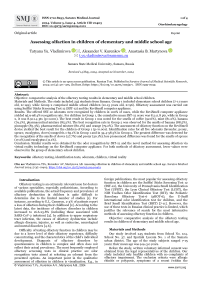Assessing olfaction in children of elementary and middle school age
Автор: Tatyana Yu. Vladimirova, Alexander V. Kurenkov, Anastasia B. Martynova
Журнал: Saratov Medical Journal @sarmj
Статья в выпуске: 4 Vol.5, 2024 года.
Бесплатный доступ
Materials and Methods. The study included 245 students from Samara. Group 1 included elementary school children (7-11 years old, n=149), while Group 2 comprised middle school children (12-15 years old, n=96). Olfactory assessment was carried out using Sniffin’ Sticks Screening Test 12 (SST-12) and the ReviSmell computer appliance. Results. The offered SST-12 odorants were recognized by children in 100% of cases, while the ReviSmell computer appliance yielded 95.9-98.4% recognition rate. For children in Group 1, the cumulative mean SST-12 score was 8.2±1.8 pts, while in Group 2, it was 8.9±1.4 pts (p<0.001). The best result in Group 1 was noted for the smells of coffee (92.6%), mint (81.2%), banana (79.2%), pharmaceutical mixture (85.2%). The best recognition rate in Group 2 was observed for the smells of banana (88.5%), pineapple (83.3%), pharmaceutical mixture (80.2%) and orange (79.2%). The assessment of olfactory function on the ReviSmell device yielded the best result for the children of Group 1 (p<0.001). Identification rates for all five odorants (lavender, peony, spruce, eucalyptus, cloves) ranged 61.1-65.1% in Group 1 and in 34.4-58.3% in Group 2. The greatest difference was detected for the recognition of the smells of cloves (27.7%) and peony (30.1%); less pronounced difference was found for the smells of spruce (17.2%) and eucalyptus (11.1%). Conclusion. Similar results were obtained for the odor recognition by SST-12 and the novel method for assessing olfaction via virtual reality technology on the ReviSmell computer appliance. For both methods of olfactory assessment, lower values were observed in the group of elementary school children.
Olfactory testing, identification tests, odorants, children, virtual reality
Короткий адрес: https://sciup.org/149148543
IDR: 149148543 | DOI: 10.15275/sarmj.2024.0403


